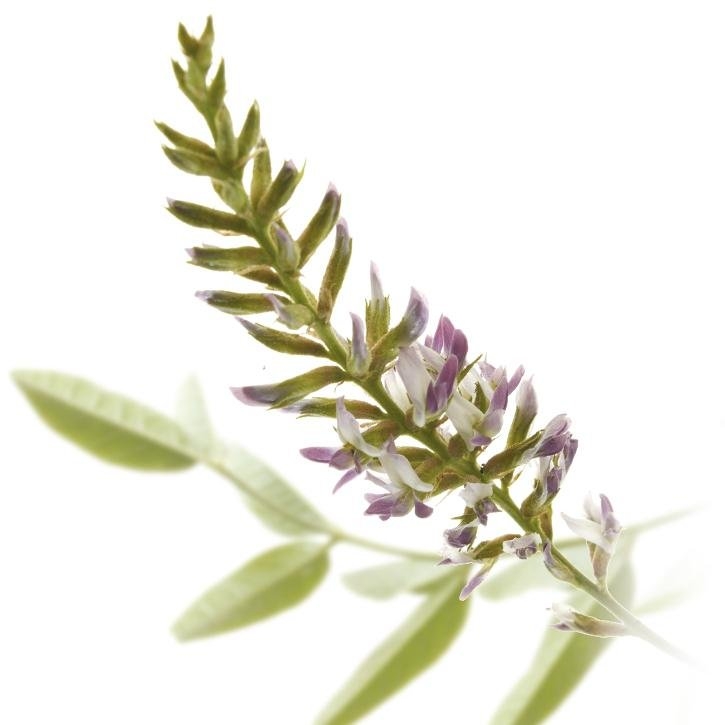Description
It is a herbaceous, vivacious and perennial plant of up to 1.5 m in height, with a vertical rhizome (underground root) somewhat tuberous that constantly sprout several rootlets penetrating to a depth of 1 meter, very sweet in flavor. The root is not much branched. Bark is brownish-gray, longitudinally grooved with sideway roots. Cylindrical stolons are 1 to 2 cm in diameter, outside appearance resembles the root itself, but sometimes it has small buds. The root and stolon fracture are coarsely fibrous. Suber is narrow; the secondary phloem is pale yellow, radially wrinkled. They xylem cylinder is yellow, compact and with a radial structure. The stolon has a central marrow which disappears in the root. The external part of the bark is not present in the dented root. Leaves compound and alternate odd-pinnately with 3 to 8 pairs of folioles (subdivisions that look like whole leaves) oval-obtuse, glandular beneath (very sticky), contrary to the root they taste bitter. Flowers arranged in axillary spikes supported on long peduncles. They are small, purplish-blue, papilionaceous, grouped in long, erect and axillary racemes. The 2-lipped calyx is glandular. Corolla is papilionaceous standing higher than the other parts of the plant. The fruit is a compressed and glabrous pod of 1.5 to 2.5 cm in length with an irregular edge a little throttled with 2-5 round seeds. It belongs to the Leguminosae-Papilionaceae family. It blooms at the beginning of summer.
Even though there are twelve different species of licorice around the five continents, the medicinal licorice is a plant original from the Mediterranean zone, central and southern Russia and Minor Asia as far as Persia. It grows in deep soil, preferably clayish. It is found mainly in Ebro, Tajo and Jarama river edges, it deteriorates towards the west end of Spain. It can be cultivated by planting little pieces of the rhizome and it is necessary to wait three years before the root becomes useful, as it starts having active principles upon the third year. It usually blooms from May to June and is harvested in autumn, when the plant starts to dry at the third year. The branches have to be cut in order to allow the plant to stay alive.
Part used
The root and rhizome, upon the third year, without the bark.
Indications
Internal use
- Digestive disorders: gastritis, gastroduodenal ulcer, gastroesophageal reflux, stomach heat, gastrointestinal spasms, meteorism, constipation, dyspepsia.
- Respiratory disorders: unproductive cough, cold, common cold, bronchitis, asthma and upper respiratory tract inflammation.
- Allergies.
- Rheumatic disorders, arthralgia, rheumatoid arthritis.
- Dysmenorrhea.
- Liver disorders: cirrhosis and chronic hepatitis.
- Adrenocortical insufficiency (Addison’s disease).
- Chronic fatigue syndrome.
Potassium intake should be increased in case no-deglycyrrhized licorice is taken daily.
External use
- Skin disorders: herpes simplex, herpes zoster, seborrheic dermatitis in the face, atopic eczema, diaper erythema or rash, etc.
- Paradontopathy and oropharyngeal mucosa inflammation (glossitis, stomatitis).
- Blepharoconjunctivitis.
Bibliography
- Real Farmacopea Española, 1997.
- British Herbal Pharmacopoeia, 1983.
- Herbal Drugs and Phytopharmaceuticals. Norman Grainger Bisset (Ed). Max Wichtl. CRC Press.1994.
- Plantas Medicinales y Drogas Vegetales para infusión y tisana. Edición española a cargo de: Salvador Cañogueral, Roser Vila, Max Wichtl.1998.
- Plantas Medicinales. Margarita Fernandez y Ana Nieto. Ed Universidad de Navarra. EUNSA 1982.
- Fitoterapia: Vademecum de Prescripción. Plantas Medicinales. Colaboran: Asociación española de médicos naturistas. Colegio Oficial de Farmacéuticos de Vizcaya.
- Matière Médicale (tomo II). RR Paris- H. Moyse. Masson 1981.
- The Complete German Commission E Monographs. Therapeutic Guide To Herbal Medicines. Mark Blumenthal. American Botanical Council 1998.
- Fitoterapia Aplicada. J.B. Peris, G. Stübing, B.Vanaclocha. Colegio Oficial de Farmacéuticos de Valencia 1995.
- Pharmacognosy, Phytochemistry, Medicinal Plants. Jean Bruneton. Lavoisier Publishing.
- Plantas Medicinales. El Dioscórides Renovado. Pio Font Quer.
- Guía de Campo de las Flores de Europa. Oleg Polunin. Ediciones Omega S.A. Barcelona, 1977.
- Pharmacognosy 9th edition. Varro E. Tyler – Lynn R. Brady – James E. Robbers.
- Jean Bruneton. Farmacognosia. Fitoquímica Plantas Medicinales. 2ª Edición. 2001. Ed Acribia. S.A.
- Bulletin officiel Nº 90/22 bis" del "Ministère des Affaires Sociales et de la Solidarité, Médicaments a base de Plantes.
- French Public Health Code.
- Benigni, R; Capra, C; Cattorini, P. Piante Medicinali. Chimica, Farmacologia e Terapia. Milano: Inverni & Della Beffa, 1962.
- Bézanger-Beauquesne, L; Pinkas, M; Torck, M. Les Plantes dans la Therapeutique Moderne. 2ª. Paris: Maloine, 1986.
- Bézanger-Beauquesne, L; Pinkas, M; Torck, M; Trotin, F. Plantes Médicinales des Regions Tempérées. Paris: Maloine, 1980.
